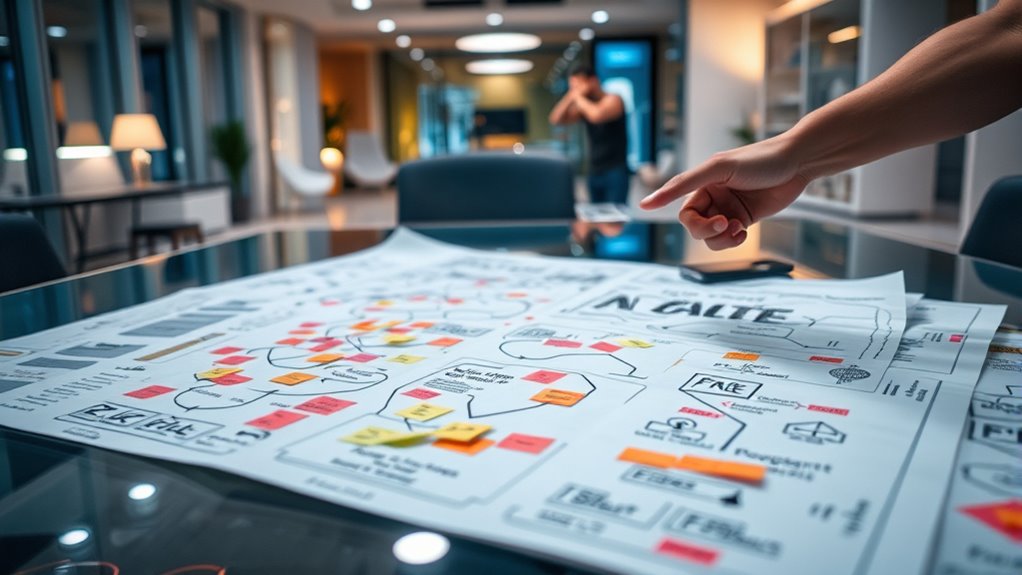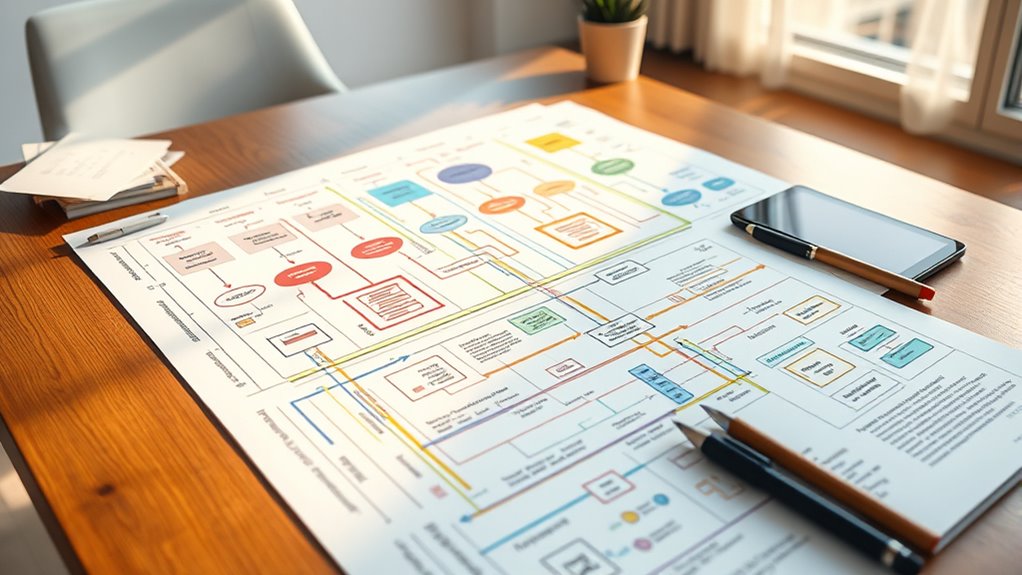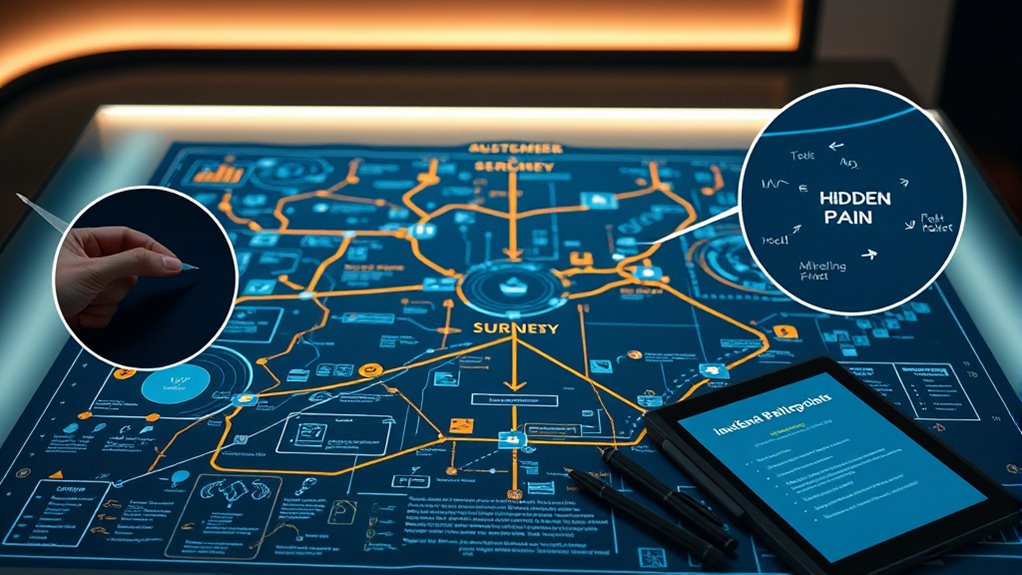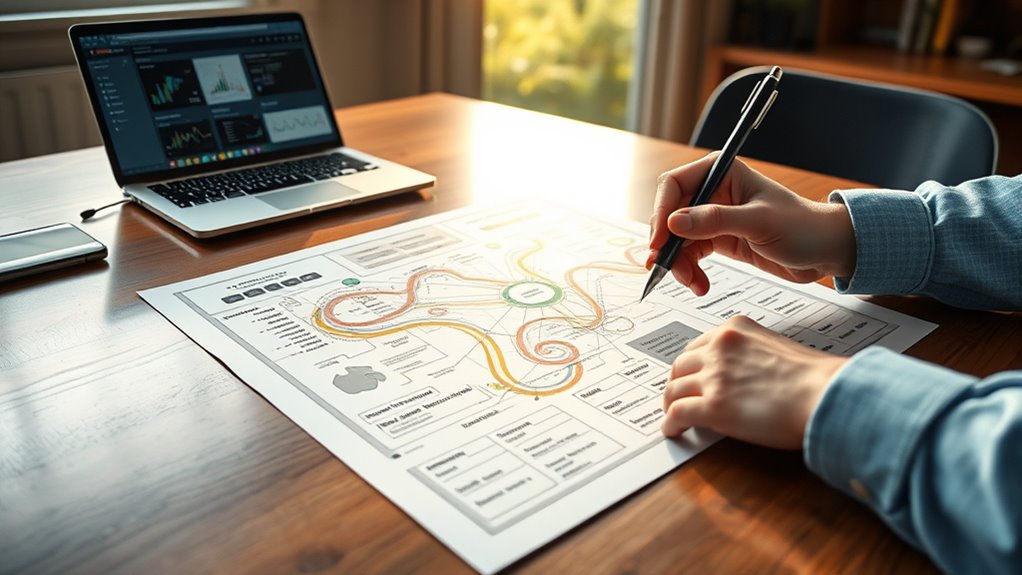Mapping service blueprints helps you visualize complex processes and uncover hidden pain points that often go unnoticed. By identifying frontstage and backstage interactions, customer emotions, and touchpoints across channels, you can pinpoint inefficiencies, bottlenecks, and frustrations. This approach not only improves service delivery but also reveals opportunities for innovation and personalization. If you keep exploring, you’ll discover how to use these insights to transform your customer experiences and streamline operations effectively.
Key Takeaways
- Service blueprints visualize complex processes to reveal hidden inefficiencies and pain points in customer journeys.
- They incorporate emotional mapping to uncover customer frustrations and moments of delight.
- Stakeholder role clarification and process flow visualization identify bottlenecks and redundancies.
- Cross-channel touchpoint integration ensures seamless experiences and uncovers gaps across platforms.
- Analyzing service hours and resource allocation helps optimize delivery and address timing-related pain points.
The Power of Visualizing Service Journeys

Visualizing service journeys transforms complex processes into clear, actionable insights. By using emotional mapping, you can identify how customers feel at each touchpoint, revealing hidden frustrations or delights. This technique helps you understand the emotional landscape, making it easier to address pain points. Technological integration enhances this process, allowing you to gather real-time data and visualize interactions seamlessly. When you map out the entire journey, you see the interconnected steps and emotional responses that often go unnoticed. This clarity enables you to prioritize improvements effectively. Recognizing emotional support needs within service experiences ensures that customer well-being is at the forefront of your design. Ultimately, visualizing service journeys gives you an all-encompassing view of customer experience, empowering you to design smoother, more empathetic services that resonate on a deeper level.
Components of an Effective Service Blueprint

An effective service blueprint clearly defines stakeholder roles to guarantee everyone understands their responsibilities. It visually maps out process flows, making it easier to spot inefficiencies or pain points. Additionally, integrating touchpoints helps you see how interactions occur across channels, providing an all-encompassing view of the service. Incorporating user privacy and cookies considerations ensures that the blueprint reflects compliance with privacy regulations and user preferences.
Clear Stakeholder Roles
Clear stakeholder roles are essential for creating an effective service blueprint because they guarantee each participant understands their responsibilities and interactions within the process. To achieve this, you should start with stakeholder mapping, identifying everyone involved—from front-line staff to management and customers. Role clarification then ensures each person’s duties are distinctly defined, reducing confusion and overlap. When roles are well articulated, it becomes easier to coordinate efforts, avoid gaps, and address potential pain points early. Clear stakeholder roles also foster accountability, making it evident who’s responsible for each action. This clarity streamlines communication and helps you visualize how different stakeholders contribute to the overall service experience, laying a solid foundation for identifying inefficiencies and improving service delivery. Additionally, understanding the service environment can help tailor stakeholder roles to better meet customer needs.
Process Flow Visualization
Effective process flow visualization turns your understanding of stakeholder roles into a tangible map of service delivery. By visually mapping each step, you create a clear picture of how the service unfolds, highlighting efficiencies and bottlenecks. This is essential for effective service mapping, as it reveals the sequence of activities and interactions among stakeholders. Process visualization helps you identify gaps or redundancies that may not be obvious in text or verbal descriptions. When you develop a detailed process flow, you gain insights into how each component fits into the overall service experience. This clarity enables you to optimize workflows, improve resource allocation, and ensure a seamless customer journey. Ultimately, process flow visualization transforms complex operations into an accessible, actionable blueprint, especially when incorporating natural elements that promote tranquility and harmony within the environment.
Touchpoint Integration
How do you guarantee your service blueprint captures the full customer experience? The key is integrating touchpoints seamlessly across channels. Digital integration ensures that interactions—whether online, mobile, or in-person—are connected, providing a unified experience. Cross-channel consistency is crucial; customers shouldn’t face discrepancies or confusion when switching between platforms. To achieve this, map out each touchpoint’s role and ensure systems communicate effectively, sharing data and updates in real-time. This creates a smooth, coherent journey that aligns with customer expectations. By focusing on touchpoint integration, you eliminate gaps and hidden pain points, making the service feel seamless and reliable. Additionally, understanding projector technology can inspire innovative ways to visualize and analyze customer journeys. Ultimately, a well-integrated blueprint offers clarity and helps you identify areas where disconnects may occur, improving overall customer satisfaction.
Identifying Frontstage and Backstage Interactions

To accurately identify frontstage and backstage interactions, you need to observe how employees and customers engage at different touchpoints. Pay attention to the service tone used during interactions, as it directly influences customer emotions. Frontstage activities are visible to customers, like conversations, greetings, or assistance, where tone and attitude set the mood. Backstage interactions happen behind the scenes—like staff coordination or preparation—that support the service but aren’t visible. By mapping these interactions, you’ll see where service shifts occur and identify moments that can affect customer feelings. Recognizing the distinction helps you improve overall service flow and ensures that every touchpoint aligns with the desired emotional experience, creating a seamless customer journey. Additionally, understanding shelf life and spoilage signs of consumables can help maintain service quality and avoid negative customer experiences.
Detecting Hidden Pain Points Through Mapping

Mapping service processes reveals hidden pain points that customers may not directly voice but still impact their experience. By engaging in emotional mapping, you can identify where customers feel frustration, confusion, or disappointment, even if they don’t explicitly mention these issues. This approach helps uncover subtle signals of dissatisfaction that might otherwise go unnoticed. For instance, analyzing user-friendly operation can shed light on unseen barriers in the service experience. Once these emotional cues are identified, pain point prioritization becomes essential, allowing you to focus on the most critical issues affecting customer satisfaction. Mapping helps visualize these pain points across the entire service journey, making it easier to detect patterns and root causes. Ultimately, this process enables you to proactively address hidden frustrations, improving overall service quality and customer loyalty.
Analyzing Customer and Employee Touchpoints

Analyzing customer and employee touchpoints provides critical insights into where service experiences succeed or fall short. By employing emotional mapping, you can identify how customers and staff feel at each interaction, revealing hidden frustrations or satisfaction. This process uncovers emotional triggers that influence perceptions and loyalty. Additionally, technology integration plays a pivotal role; tracking digital interactions helps you understand how well systems support the service journey. For instance, monitoring support hours at places like PlayStation Support Hours can reveal timing issues that impact user satisfaction. Combining these approaches allows you to pinpoint specific moments that impact overall experience, whether positive or negative. You’ll gain a clearer picture of pain points and opportunities for improvement, ensuring the service aligns with customer expectations and employee workflows. Ultimately, this analysis helps you create a seamless, emotionally resonant service experience.
Leveraging Blueprints to Improve Service Efficiency

Leveraging service blueprints transforms the way you identify inefficiencies and streamline operations. By visualizing every step of your service process, you can pinpoint bottlenecks and redundant tasks that hinder performance. This clarity drives service innovation, enabling you to redesign workflows and introduce improvements that boost efficiency. Service blueprints also foster organizational alignment by providing a shared understanding of roles and responsibilities, ensuring everyone works toward common goals. With clear insights, you can better allocate resources and eliminate waste, leading to faster delivery times and enhanced customer satisfaction. Additionally, understanding store hours can facilitate better scheduling and resource planning within your service processes. Ultimately, using blueprints as a strategic tool helps you optimize service delivery, making your organization more agile and responsive to changing needs. This approach empowers you to create smoother, more effective service experiences.
Case Studies: Transforming Services With Blueprints

Have you ever wondered how organizations turn complex service processes into clear, actionable insights? Case studies reveal that using service blueprints drives digital innovation by exposing hidden pain points and streamlining operations. For example, a healthcare provider reimagined patient experiences by mapping every touchpoint, enabling tailored service personalization. This approach uncovered inefficiencies and led to targeted improvements, reducing wait times and enhancing satisfaction. Similarly, a retail chain used blueprints to optimize customer journeys, integrating digital tools that made interactions seamless. These transformations demonstrate how blueprints empower organizations to innovate digitally while delivering more personalized services. By visualizing processes, you gain clarity, identify pain points, and access opportunities for meaningful change—making blueprints essential for service transformation. Additionally, understanding My dog’s names can inspire personalized touches that make service experiences more engaging and memorable for customers.
Frequently Asked Questions
How Do Service Blueprints Adapt to Rapidly Changing Customer Behaviors?
You can adapt service blueprints to rapidly changing customer behaviors by actively incorporating customer feedback and leveraging technology integration. Regularly update your blueprints based on new insights, ensuring they reflect evolving preferences. Use real-time data and automation tools to identify emerging pain points quickly. This approach allows you to stay agile, continuously improving your service design and delivering a seamless experience that aligns with your customers’ current needs.
What Tools Best Support Digital Versus Physical Service Blueprint Creation?
When creating service blueprints, you can rely on digital tools like Lucidchart or Miro to quickly collaborate and update diagrams online, making them ideal for dynamic environments. For physical models, you might use whiteboards, sticky notes, and printed templates to visualize processes tangibly. Both approaches serve different needs; digital tools excel in flexibility, while physical models promote hands-on engagement and real-time brainstorming.
How Can Blueprints Be Customized for Different Industries or Service Types?
Did you know that industry-specific mapping can boost customer satisfaction by up to 30%? To customize blueprints for different industries or service types, you should tailor each map to reflect unique customer journeys, touchpoints, and pain points. Focus on service customization by incorporating industry standards, customer expectations, and operational nuances. This targeted approach guarantees your blueprints accurately represent your service environment, making improvements more effective and aligned with specific industry needs.
What Are Common Pitfalls When Interpreting Complex Service Blueprints?
When interpreting complex service blueprints, you should watch out for overgeneralization pitfalls that can lead to missing specific issues. Ambiguous symbols also pose a challenge, causing confusion and miscommunication. To avoid these pitfalls, clarify symbols and focus on detailed, accurate representations. This way, you guarantee a clear understanding of the service process, helping you identify hidden pain points more effectively and improve the overall customer experience.
How Do Organizations Ensure Continuous Improvement Using Service Blueprints?
Think of your organization as a garden that needs constant tending. To guarantee continuous improvement, you should establish feedback loops that gather insights from customers and staff regularly. Engage stakeholders actively, turning their input into actionable changes. By nurturing these relationships and iterating based on real feedback, you keep your service blooming, revealing hidden pain points and transforming your blueprint into a dynamic tool for ongoing growth and excellence.
Conclusion
By boldly bridging the gaps between gaps, blueprints bring buried blemishes into bright daylight. As you analyze, align, and anticipate, you’ll uncover unseen stressors and streamline service scenes. Embrace the elegance of effective mapping to master moments and mend mishaps. With clarity and creativity, you can convert clutter into clarity, turning hidden hardships into harmonious highlights. So, seize the power of visualized service, and transform trouble into triumph through thoughtful, thorough blueprinting.









